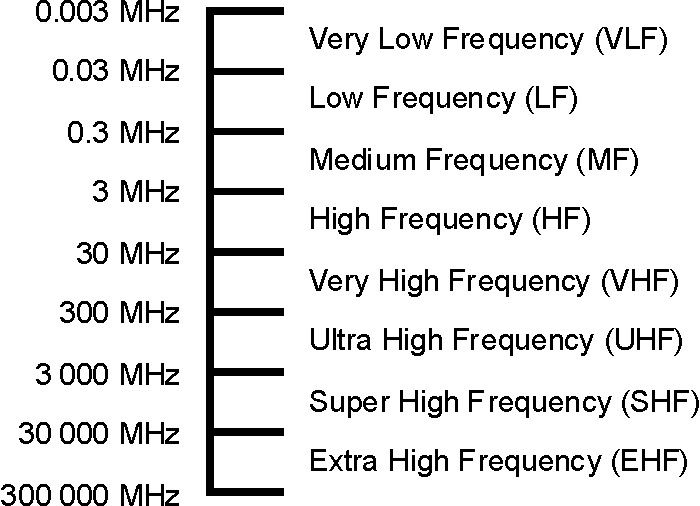Ham Radio
Sub Pages
Table of Contents
Frequency Ranges

Frequency Ranges - Split by order of magnitude:
| HAM | Magnitude | Bottom | Top | Name |
|---|---|---|---|---|
| ? | 3x10^0 | 0.003 MHZ | 0.03 MHz | Very Low Frequency (VLF) |
| ? | 3x10^1 | 0.03 MHZ | 0.3 MHz | Low Frequency (LF) |
| 3x10^2 | 0.3 MHZ | 3 MHz | Medium Frequency (MF) | |
| 10 meters 28-29.7 MHz | 3x10^3 | 3 MHZ | 30 MHz | High Frequency (HF) |
| 6 meter 50-54 MHz 4 meter 70-70.5 MHz 2 meter 144-148 MHz | 3x10^4 | 30 MHZ | 300 MHz | Very High Frequency (VHF) |
| 70 centimeter 420-450 MHz | 3x10^5 | 300 MHZ | 3,000 MHz | Ultra High Frequency (UHF) |
| ? | 3x10^6 | 3,000 MHZ | 30,000 MHz | Super High Frequency (SHF) |
| ? | 3x10^7 | 30,000 MHZ | 300,000 MHz | Extreme High Frequency (EHF) |
ref: [1]
The United States Radio Frequency Spectrum Chart
The United States Radio Frequency Spectrum Chart (PDF)
United States Frequency Allocation Chart
Utah County Clubs
Stake Emergency Net
ARES
Amateur Radio Emergency Service (ARES)
Utah County ARES (UCARES)
When: weekly training nets held every Tuesday at 2100h (9pm) on the 147.34 repeater:
Where: 147.34 MHz + (100.0 Hz)
Training nets are held every Tuesday evening at 2100 hours local time on the 147.34+ repeater
RACES
Radio Amateur Civil Emergency Service (RACES)
- "Founded in 1952, the Radio Amateur Civil Emergency Service (RACES) is a public service that provides a reserve communications group within government agencies in times of extraordinary need. During periods of activation, RACES personnel are called upon to perform many tasks for the government agencies they serve. Although the exact nature of each activation will be different, the common thread is communications."
N7BSA.ORG
When: Every Wednesday at 8pm (or on the first wednesday after the meeting). The next net is on October 31st
Where: 147.47+ with a tone of 100hz
Repeater Directory
The Utah VHF Society: Frequency Coordination
Antennas
J-Pole Antenna
"The J-pole antenna is an end-fed omnidirectional dipole antenna that is matched to the feedline by a quarter wave transmission line stub. Matching to the feed-line is archived by sliding the connection of the feedline back and forth along the stub until an SWR as close as possible to 1:1 is obtained. Since this is a half-wave antenna, it will exhibit gain over a quarter-wave ground-plane antenna." [2]
The J-Pole is quite simply an antenna that works marvelously. [3]
As a half wave antenna, the J-Pole doesn't need any radials or a ground plane to work. Average gain with a 2 meter J-Pole is about 3 db. Many like to compare the gain and antenna pattern to that of a Ringo Ranger. The biggest advantage of the J-Pole is that it is at DC ground, so it can be mounted just about anywhere and still work. [4]
The J-pole is somewhat sensitive to surrounding metal objects, and should have at least a quarter wavelength of free space around it. [5]
Detailed J-Pole construction plans
Purchase J-Pole Antenna for about $30 + $8 shipping
Dipole Antenna
"A dipole antenna is an antenna with a center-fed driven element for transmitting or receiving radio frequency energy. These antennas are the simplest practical antennas from a theoretical point of view." [6]
"A Slim Jim or J-pole is a form of end-fed dipole connected to a quarter-wave monopole used as a stub matching section." [7]
Ground Plane Antenna
Rubber Ducky Antenna
"The Rubber Ducky antenna is an electrically short antenna which functions somewhat like a base-loaded whip or monopole antenna and is sealed in a rubber or plastic jacket to protect the antenna. Electrically short antennas are often used in portable equipment because a one-quarter wave-length element, necessary for resonance of a linear element over a ground-plane, is often too long for convenient portable operation." [8]
"...where safety and robustness take precedence over antenna capabilities."
Terms
Ground Plane
"In electrical engineering, a ground plane is an electrically conductive surface." [9]
A Quick and Simple 2 Meter Ground Plane Project!
db and decibel
See #Decibel
Logarithm
 is equivalent to
is equivalent to

y = log b(x) is equivalent to x = b^y
Decibel
See Decibel
Coaxial Cable
See Coax Cable Attenuation Details
EchoLink
- "EchoLink® software allows licensed Amateur Radio stations to communicate with one another over the Internet, using voice-over-IP (VoIP) technology. The program allows worldwide connections to be made between stations, or from computer to station, greatly enhancing Amateur Radio's communications capabilities. There are more than 200,000 validated users worldwide — in 162 of the world's 193 nations — with about 3,800 online at any given time."
ICOM IC-T2H
- Icom IC-T2H (IC T2 H ICT2H)
- Reviews Summary for Icom IC-T2H
- Icom IC-T2H (IC T2 H ICT2H) Expand TX/RX frequency
Mods:
Repeaters
Radios
Wants
Stores
Options
| Style | Make | Model | Band | Watts | Price |
| Mobile | Yaesu / Vertex Standard | FT-7800R + YSK-7800 | 144/440 MHz | 50/40 W | $230 |
| Mobile | Icom | IC-208H | 144/430 MHz | 55/50 W | $280 |
| Mobile | Yaesu / Vertex Standard | FT-1802M | 144 MHz | 65 W | $133.95 |
| Mobile | Yaesu / Vertex Standard | FT-2800M | 144 MHz | 50 W | $117.95 |